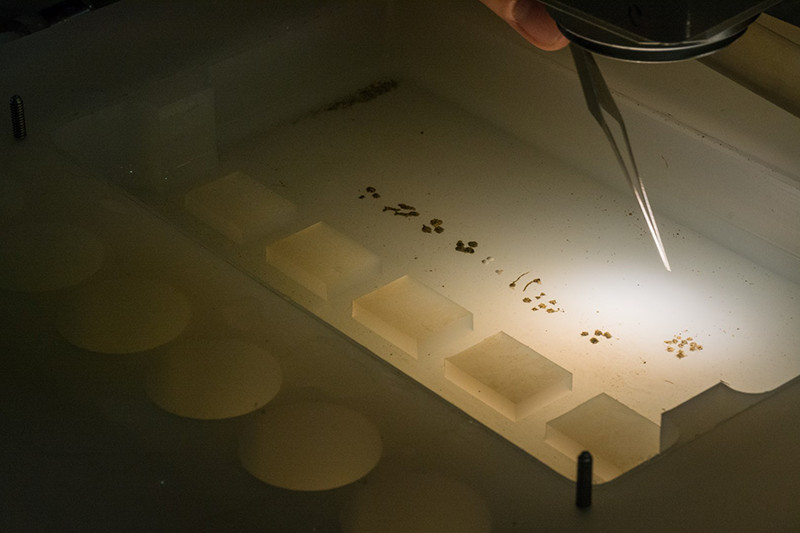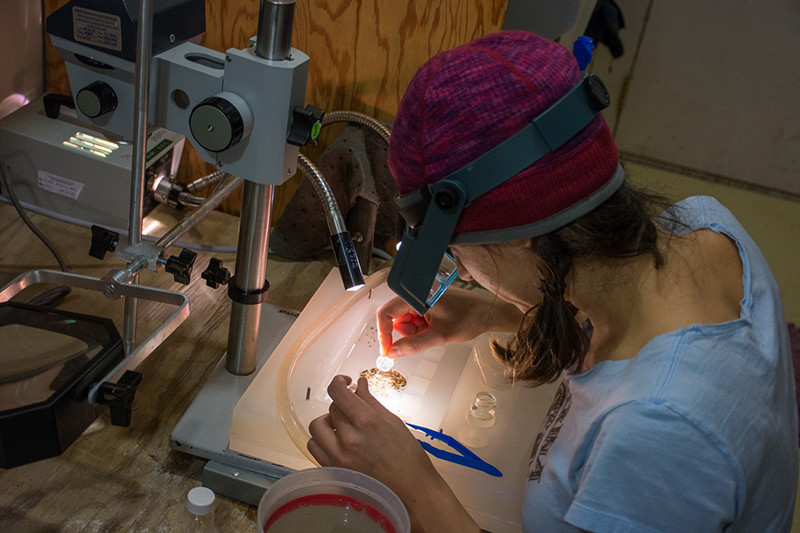Glue GenesHow Even Single-Celled Organisms Can Be Enormously ComplicatedPosted December 13, 2016
At the mouth of the McMurdo Dry Valleys, along a small spit of land called New Harbor, a team of scientists and divers have worked for decades to unlock the genetic secrets of foraminifera, some of the world’s largest single-celled organisms. 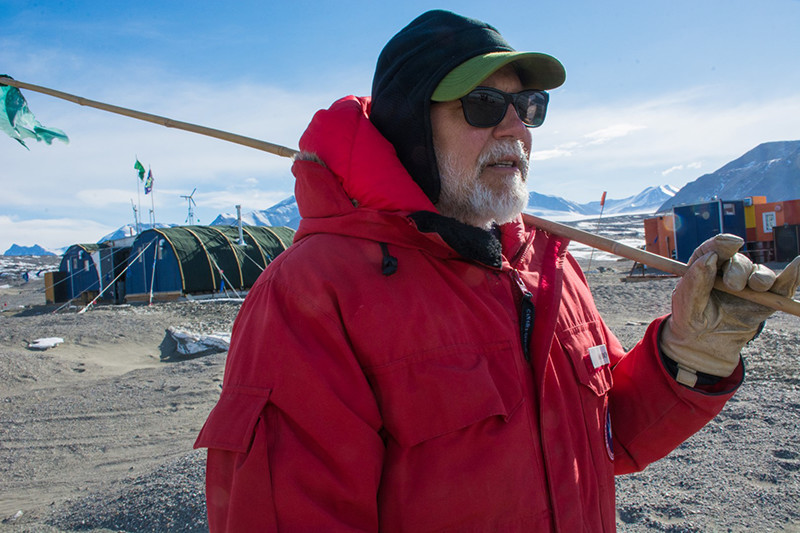
Photo Credit: Mike Lucibella
Sam Bowser has been coming to New Harbor to study the glue produced by foraminifera since 1990.
“We’re looking for things that could apply to medicine and biotechnology,” said Sam Bowser, a cell biologist at the New York State Department of Health. “I’ve been interested in the glue that they secrete to build their shells.” He and his changing team of researchers have been returning to this site to study the nearly-microscopic organisms that live along the seafloor since 1990. Over the years, Bowser has become a fixture of the National Science Foundation-managed U.S. Antarctic Program. However after 26 years, he is retiring, leaving behind a legacy of dedicated research toward understanding the complex organisms that inhabit the benthos around the region. 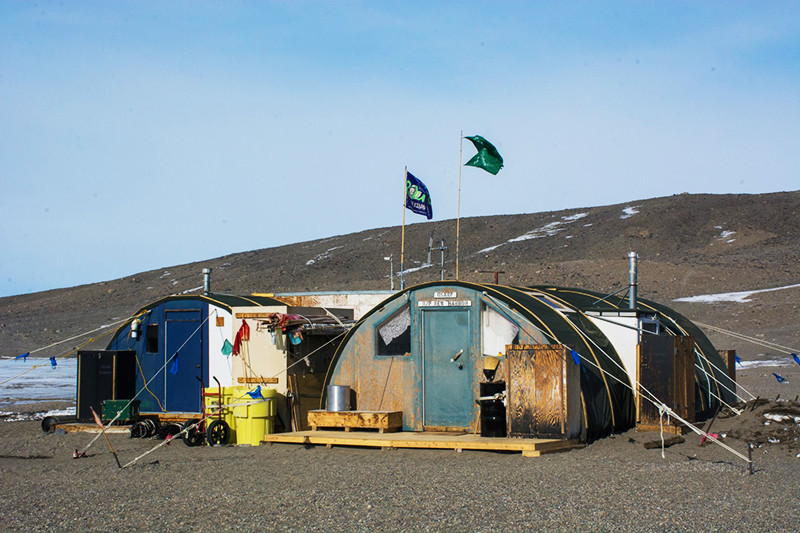
Photo Credit: Mike Lucibella
The New Harbor camp sits along the shoreline of Explorer’s Cove, at the mouth of the McMurdo Dry Valleys.
Single-celled foraminifera, or “forams” as they’re commonly called, grow in abundance in the cold waters around the harbor. Though they’re only made up of one cell, they’re not really microorganisms, as many species can be seen with the naked eye. “They range from the microscopic to fit-in-the-palm-of-your-hand sized,” Bowser said. “If all the cells in your body were that size, you would be orbiting the Earth.” These creatures first arose in the Earth’s primeval oceans about 600 million years ago and have since flourished into more than 4,000 different species across the globe. “They’re early evolving organisms and they’ve been exploring evolutionary space for that long of a time so they’ve come up with innovative solutions to various types of physiological problems,” Bowser said. “Hopefully one of those things that they’ve explored on their own will be useful to us.” The Glue That Binds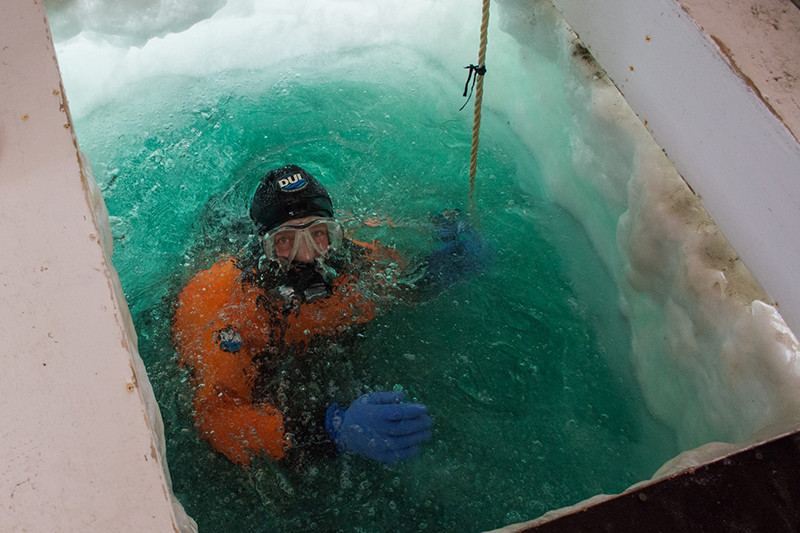
Photo Credit: Mike Lucibella
Paul Cziko prepares to dive at New Harbor to gather sediment from the seafloor, home to numerous foraminifera.
Forams build their shells from materials around them. Some of the more sophisticated ones grow their own calcium carbonate shells akin to those of snails or clams, but Bowser is studying the more primitive species that live around McMurdo Sound. They build their shells out of the grains of sand and dirt around them by sending out sticky tendrils that grab onto nearby particles and fuse them together with their own natural adhesive. It’s this glue that Bowser has been studying. These forams have an impressive ability to cement together different materials while immersed in salt water, something that some of the best glues invented by humans have a hard time with. But teasing apart exactly how they’re able to produce this natural mortar has proven elusive. “There are [human] tissues that are hard to suture together, like lung tissue and pancreas, so if you could just slather on glue, that would be a pretty neat application,” Bowser said. Since Bowser began been looking the secret of the forams’ secretions, the technology he’s been using in his search has undergone a drastic change. “It started as a collecting trip to get specific species; relatively large numbers of them because we wanted to do hardcore biochemistry,” Bowser said. “Grind them up, pull out the proteins and study the isolated proteins.” 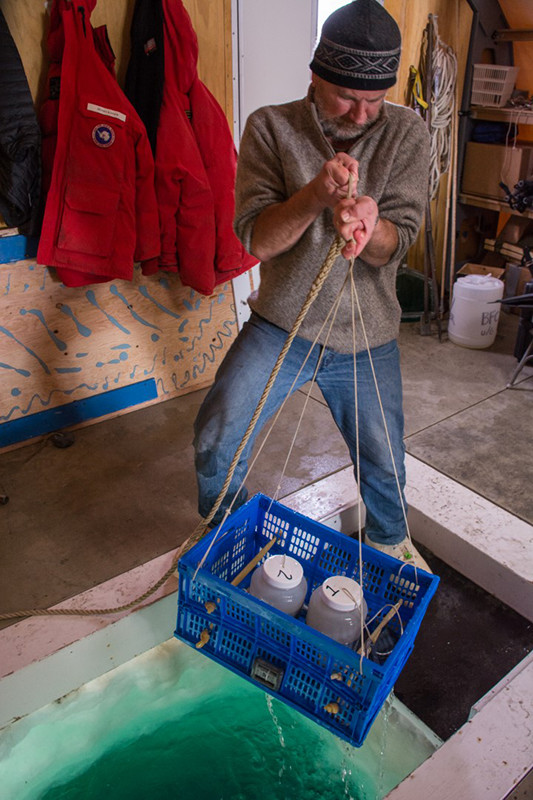
Photo Credit: Mike Lucibella
Michael Koonce hauls up a load of seafloor sediment. The researchers will sift out the foraminifera and study how they make their shells by binding sand grains together.
It soon became apparent that this approach alone wouldn’t be enough to unlock all the sophisticated ways these organisms create their binding agents. Firstly, their size alone was a major stumbling block. Though large for a single-celled organism, the creatures are still so small that even after collecting thousands of them, there was scarcely enough material to do a comprehensive biochemistry analysis. But even if they had collected enough to run a complete analysis of all the proteins, amino acids and carbohydrates in the forams’ adhesive, it’s how the forams bind these substances together on a molecular level that gives the adhesive its strength. “It’s a one celled organism so you’d think that it would be a relatively simple process to excrete this adhesive,” Bowser said. “It’s incredibly complicated.” Like most natural adhesives, they seem to have three components: a filler that binds two surfaces together, a catalyst that lets the filler set firm against what it’s sticking to and a fibrous component for strength. How forams combine the different materials and how they work together is something that rote biochemistry can’t explore on its own. “How that was all put together is still a mystery,” Bowser said. “What we’re up to now is we will just find out what every gene is in all of these species, and then mine the information we get, the genetic information, for the gene products of interest.” New Insights from Modern Genetics
Photo Credit: Mike Lucibella
Paul Cziko and Amanda Andreas start to sift freshly hauled sediment from the seafloor to find the foraminifera within.
Studying their genes and DNA is more fundamental approach to understanding these seemingly simple creatures. It’s akin to reading the source code of a computer program to see how it works from the underlying commands. In the process, exploring the genetics of these organisms opened up whole new areas of research. It’s let the researchers better understand not just the foram’s biological adhesives, but nearly everything about them from their internal “motors” to their evolutionary history. Michael Koonce, also with the New York State Department of Health, was focusing last year on how the forams’ tiny internal organs seem to move about and perform their functions as efficiently as their relatives in warmer climates. “If you just watch it on a microscope, you can see organelles move around back and forth,” Koonce said. “That’s all driven by ‘machines’ that burn adenosine triphosphate that creates force and takes steps along a track.” Able to thrive in temperatures as cold as -2 degrees Celsius, it stands to reason that the fuel used to propel these organisms’ organelles along their internal tracks in polar waters is somehow structured differently than if they lived in warmer seas. With an eye towards potential applications in chemotherapy, Koonce is hoping to find out what that difference is. However studying the movement of organelles in frigid climates is such a new area of research that Koonce’s first task was to use cameras to track and definitively measure their speed inside the forams. “We have to demonstrate that they are moving as fast as they do in other organisms,” Koonce said. “Then, using genomics go back through and isolate the [gene] sequences and identify what’s different about these motors that enable them to do things.” Because of the difficulty in transporting live specimens across the planet, the researchers gather all of their data on the living organisms in the small lab at New Harbor. The more intensive genetic analysis, like mapping their evolutionary history, is done on frozen samples at their home institutions. In every organism’s genetic code there are long sections of seemingly inert DNA, segments of code with no discernable function. However scientists have found a sort of molecular clock embedded in this “junk DNA.” Mutations occur in these segments at fairly regular intervals over time and by analyzing these mutations, scientists can determine approximately when in history different species branched away from their common ancestor. “We use it as a tool in our lab to help answer some evolutionary questions about individual genes,” Bowser said. 
Photo Credit: Mike Lucibella
Sam Bowser runs a test of the foraminifera in his laboratory at New Harbor.
This way, the researchers can track the genetic diversity of the forams around the region and see how closely related they are. This matters because a change in their environment could potentially have an impact on their population. It could either be a minor population shift or dramatic one, depending on how robust each species is and how diverse the populations are. Because forams are an important part of multiple food chains in the area, a disruption to the foram population could be felt by higher level organisms throughout the local environment. This year, researcher Susan Goldstein from the University of Georgia will be growing a number of forams in tanks of different temperatures to see how they thrive in warmer waters. “She’s interested in the capacity of forams to adapt to changing conditions and proliferate,” Bowser said. “It might tell you what in a predictive sense, what might become dominant in a warming ocean.” A better understanding of their genome might also offer insight into one of the other, lingering mysteries about the shapes of their shells. “Each species custom builds its own shell. They’re kind of like snowflakes in that no two shells are exactly alike, but the overall pattern is preserved from species to species, and they’re vastly different from one another. Some are triangular, some are round, some are round with different grains. The organism by microscope looks the same, so how are they creating these different shapes and sizes and forms and for what purpose?” Koonce said. “You have to wonder how on Earth do these, one of the most simple single cells, can create such form and diversity.” NSF-funded research in this story: Sam Bowser, New York State Department of Health, Award No. 9725830. |



For USAP Participants |
For The Public |
For Researchers and EducatorsContact UsU.S. National Science FoundationOffice of Polar Programs Geosciences Directorate 2415 Eisenhower Avenue, Suite W7100 Alexandria, VA 22314 Sign up for the NSF Office of Polar Programs newsletter and events. Feedback Form |

